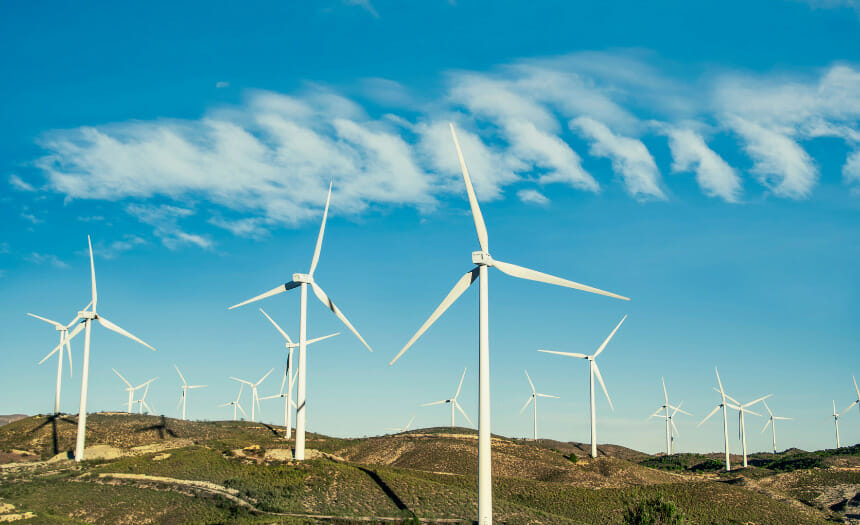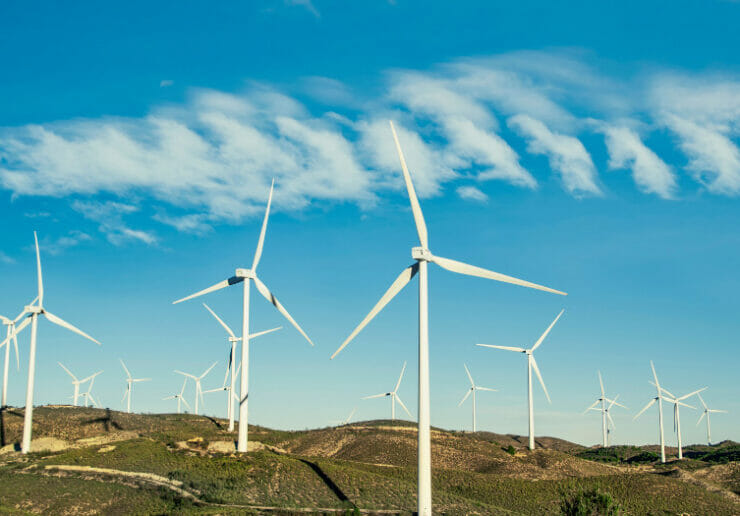
The wind industry has witnessed significant expansion as a clean and sustainable energy source. Today, wind is the leading non-hydro renewable technology. Wind turbines harness the power of the wind to generate electricity, contributing to the global shift towards renewable energy sources and reducing reliance on fossil fuels.
Within the construction of wind turbine towers, base plates and anchor plates serve as crucial components. These plates are critical components of the wind industry. Without them, the turbines used to generate wind energy would not be able to stand up to the elements.
Kloeckner Metals is one of the largest metals supply, manufacturing, and services companies in North America with special capabilities for the wind industry. Kloeckner Metals combines a national footprint with the latest fabrication and processing technologies and most innovative customer service solutions. Request a quote today.
In this article, we delve into the fabrication process of base plates, exploring the different types used, the materials involved, the manufacturing processes, and important considerations in base plate design.
The wind industry has experienced rapid growth over the past few decades, and it shows no signs of slowing down. In fact, the global wind power capacity reached over 2100 terawatt hours (TWh) by the end of 2022. As the demand for renewable energy sources increases, more wind turbines are being installed across the globe.

Wind requires steel to produce energy. One wind turbine tower requires 165 tons of steel just for the foundation. As the wind industry continues to grow, the demand for steel base plates, metal base plates, steel anchor plates, and metal anchor plates will only increase.
Wind turbine towers require a combination of strength, durability, and flexibility to withstand harsh environmental conditions and generate energy efficiently.
These towers are complex structures that consist of several parts. The tower itself is a tall structure that houses the nacelle, which contains the gearbox, generator, and control system. The blades, which are typically made of composite materials, are attached to the nacelle and capture the energy from the wind.
Wind turbine towers can range in height from 260 to 400 meters, depending on the wind conditions in the area and the size of the turbine. A wind turbine tower’s foundation must support the weight of the entire structure, ensuring stability and safety. Steel base plates anchor the foundation to the ground and transfer the load of the structure to the soil.
Their design has evolved over the years to meet the changing needs of the wind industry. Newer designs often incorporate advanced materials and manufacturing techniques to ensure maximum strength and durability.
Precision and quality are of utmost importance when fabricating for the wind industry. Manufacturers utilize state-of-the-art equipment and processes, such as CNC machining and laser cutting, to ensure accurate dimensions and smooth finishes.
Base plates are often confused with anchor plates, but these two types of plates serve different purposes. While the former are used to support the tower structure, the latter are embedded in the ground, anchoring the tower and preventing it from tipping over.
Anchor plates provide resistance against external forces such as wind, seismic events, and snow loads. These plates distribute the immense loads exerted by the tower, rotor, and blades into the foundation. Anchor plates are usually larger and more heavy-duty than base plates, as they need to withstand immense forces. They are also made of strong metals such as steel, thanks to its high strength-to-weight ratio and their resistance to corrosion.
Metal base plates for posts, also known as mounting plates, are used to secure the tower to the foundation. These plates are typically square or rectangular in shape and are welded or bolted to the bottom of the tower. They provide a stable and solid base for the tower, ensuring it remains upright even in strong winds.
Different types are utilized in wind turbine tower construction, each catering to specific requirements and conditions. These include traditional square or rectangular, circular, and custom-designed types. The choice of base plate type depends on factors such as tower design, soil conditions, and load distribution requirements.
Two main types are used in the wind industry: onshore and offshore. Onshore base plates are used in wind turbines that are built on land, while offshore base plates are used in turbines that are constructed in bodies of water, such as oceans or lakes.
Onshore base plates are typically made from carbon steel, as it provides the necessary strength and durability to withstand the forces generated by wind turbines. These base plates are usually secured to a concrete foundation and act as a support structure for the entire turbine tower.
Offshore base plates, on the other hand, require additional corrosion resistance due to the harsh marine environment. Therefore, they are often made from materials such as stainless steel or aluminum alloys that have superior corrosion resistance properties. These base plates are also designed to withstand the dynamic forces exerted by wind and waves.
It is important to note that while onshore types are more commonly used, the offshore wind industry is growing rapidly, and advancements in technology may result in the development of specialized base plates for offshore applications in the future.
Base plates used in the wind industry are typically made from strong and durable metals that can withstand the harsh outdoor environment. Therefore, the most commonly used metals for base plates are steel and aluminum.
Steel plate is a popular choice due to its high strength and excellent corrosion resistance properties. It can withstand the strong forces exerted by the wind turbine, ensuring stability and safety. Additionally, steel is a cost-effective option and can be easily fabricated into various shapes and sizes to meet the specific requirements of different wind turbine towers. Typical steel grades include A572-50, A588, and A36.
Aluminum plate is another commonly used metal for base plates, especially in lightweight wind turbine designs. It offers excellent corrosion resistance and is much lighter compared to steel, making it easier to transport and install. However, aluminum is not as strong as steel, so it is typically used in smaller wind turbine towers or in combination with other metals for added strength.
In some cases, base plates may also incorporate other metals, such as stainless steel or galvanized steel, to enhance their corrosion resistance. These metals provide an extra layer of protection against rust and erosion, ensuring the longevity of the base plate in the challenging wind industry environment.
Fabricating base plates for wind turbines involves a series of precise manufacturing processes. These processes may include cutting, drilling, welding, forming, and surface treatment.
One crucial piece of equipment used in the fabrication process is a CNC plasma cutting machine. This machine allows for precise and accurate cutting of the base plate material. The base plate is then subjected to a series of bending and shaping processes using hydraulic press brakes, rollers, and other metalworking machinery. These processes ensure that the base plate is shaped correctly and can fit securely onto the wind turbine tower.
Welding is another critical process in creating base plates. Welders use specialized welding equipment, such as TIG or MIG welding machines, to join the different components of the base plate together. This creates a strong and reliable structure that can withstand the extreme conditions in which wind turbines operate.
After welding, base plates may be ground, leveled, sandblasted, and treated for corrosion prevention before receiving a final inspection.
To ensure the quality of the base plates, they often undergo non-destructive testing (NDT) techniques such as ultrasonic testing or magnetic particle inspection. These tests help detect any defects or imperfections in the base plate, ensuring that it meets the required standards for the wind industry.
One of the major trends in wind turbine tower design is the construction of taller wind towers. As technology continues to advance and turbines become more efficient, manufacturers are seeking to capture stronger and more consistent winds at higher altitudes.
New designs incorporate thicker walled steel or higher grades of steel, enabling wind turbine Original Equipment Manufacturers (OEMs) to reach new heights while maintaining the integrity of established tower designs from the past two decades.
These taller towers also require stronger and more robust base plates to support the increased weight and height. Base plates play a crucial role in ensuring the stability and integrity of the entire wind turbine structure. With advancements in materials and fabrication techniques, base plates are being designed to handle the increased loads and stresses associated with taller wind towers.
When designing base plates, manufacturers consider several crucial factors, including load requirements, foundation conditions, wind speeds, and seismic activity in the area.
Engineers must also consider the height and weight of the turbine tower and the equipment used to transport it to the construction site. They must ensure that the base plate design is strong enough to support the tower’s weight while withstanding extreme weather conditions. It’s also vital to design the base plates in such a way that they can be transported by rail or truck within legal limits, as this can have a significant impact on project costs.
In addition, they should be fabricated with materials that are corrosion-resistant, durable, and able to withstand exposure to the elements over the long term.
Fabricating base plates for wind turbine towers is a vital aspect of the wind industry’s growth. By understanding the various types, the metals used in their fabrication, the manufacturing processes involved, and the important design considerations, we can ensure the continued development of sustainable and efficient wind energy generation.
Kloeckner Metals is one of the largest metals supply, manufacturing, and services companies in North America with special capabilities for the wind industry. Kloeckner Metals combines a national footprint with the latest fabrication and processing technologies and most innovative customer service solutions. Request a quote today.

Steel base plates are fundamental elements employed in various manufacturing...
Metal fabrication is a critical process that transforms raw metal...
The solar industry has undergone a significant transformation by incorporating...

X
The Kloeckner Metals website uses modern technologies. Unfortunately, your browser doesn't support those technologies.
Download the latest version of one of these browsers to experience the site: